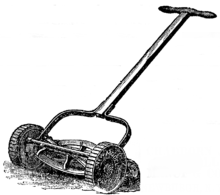Edwin Beard Budding
Edwin Beard Budding | |
|---|---|
| Born | Edwin Beard Budding 25 August 1796 Eastington, Gloucestershire, England |
| Died | 25 September 1846 (aged 50) Dursley, Gloucestershire, England |
| Occupations |
|
| Known for |
|
Edwin Beard Budding (25 August 1796 – 25 September 1846[1]), an engineer born in Eastington, Stroud, was the English inventor of the lawnmower (1830) and adjustable spanner (1842).
Lawnmower[edit]

Budding had the idea of the lawnmower after seeing a machine in a local cloth mill that used a cutting cylinder (or bladed reel) mounted on a bench to trim the irregular nap from the surface of woolen cloth and give a smooth finish.[2] Budding's mower was designed primarily to cut the lawn on sports grounds and extensive gardens, as a superior alternative to the scythe, and was granted a British patent on 31 August 1830.[3] It took ten more years and further innovations to create a machine that could be worked by animals, and sixty years before a steam-powered lawn mower was built. The first machine produced was 19 inches in width with a frame made of wrought iron. The mower was pushed from behind with motive power coming from the rear land roller which drove gears to transfer the drive to the knives on the cutting cylinder; the ratio was 16:1. There was another roller placed in between the cutting cylinder and the land roller which was adjustable to alter the height of cut. On cutting, the grass clippings were hurled forward into a tray-like box. It was soon realized, however, that an extra handle was needed in front of the machine which could be used to help pull it along. Two of the earliest Budding machines sold went to Regent's Park Zoological Gardens in London and the Oxford Colleges.[4] In an agreement between John Ferrabee and Edwin Budding, dated 18 May 1830, Ferrabee paid the costs of development, obtained letters of patent and acquired rights to manufacture, sell and license other manufacturers in the production of lawn mowers. Budding realized that a similar device could be used to cut grass if the mechanism was mounted in a wheeled frame to make the blades rotate close to the lawn's surface. Budding went into partnership with a local engineer, John Ferrabee, and together they made mowers in a factory at Thrupp near Stroud.[5]
Examples of the early Budding type mowers can be seen in Stroud Museum, the London Science Museum and at Milton Keynes Museum.
Adjustable spanner[edit]
Budding is also credited with the invention of the screw adjustable spanner in 1842.[6]
Firearms[edit]
Budding's engineering and manufacturing skills also extended to the production of a five-shot percussion revolver having brass manually-rotated barrels in about 1830. [7]
References[edit]
- ^ baptism and burial registers 1813-1988, Gloucestershire Church of England diocese; grave marker, St Mark's, Dursley
- ^ "History of British Gardening Series - Georgian and Regency era". BBC. Archived from the original on 16 February 2010. Retrieved 9 November 2018.
- ^ US RE 8560, Passmore, Everett G., "Improvement in Lawn-Mowers", published 23 February 1869, issued 28 January 1879; see pg 1, col 2. For a copy, see Google Patents copy. This source indicates the patent number as "6,080". According to "British patent numbers 1617 - 1852 (old series) Archived 2011-10-17 at the Wayback Machine", the patent number was assigned sometime after 1852 and took the form of "6080/1830".
- ^ "The Hall & Duck Trust: Lawn Mower History Part 1". Hdtrust.co.uk. Retrieved 23 April 2011.
- ^ "People at the cutting edge: lawnmower designers". Parks & Gardens UK (University of York / Association of Gardens Trusts). Archived from the original on 26 February 2012. Retrieved 24 May 2009.
- ^ Digital Stroud
- ^ "The Book of Guns & Gunsmiths", North & Hogg, ISBN 1-86160-732-6
External links[edit]
- How a chance comment during a park walk led to a fascinating journey..., National Development Team for Inclusion, 20 July 2017
- Lawn mower lifeline for the gardening hobbyist..., Greenry enthusiast Team published, 27 July 2022
